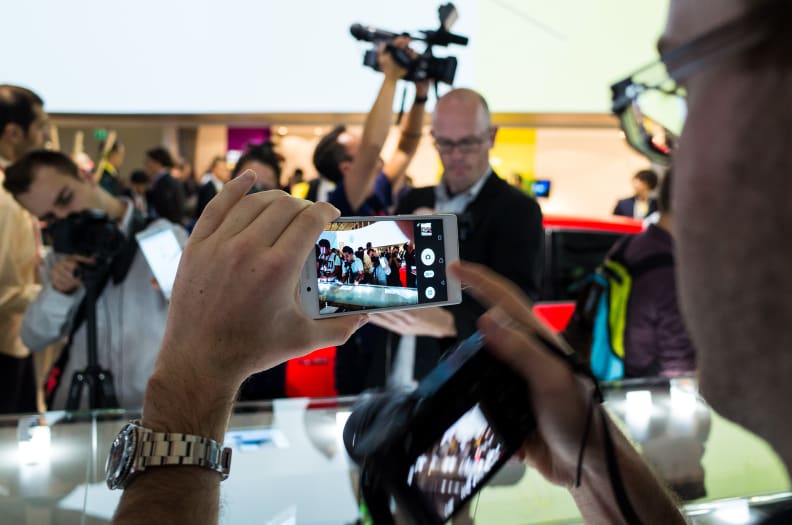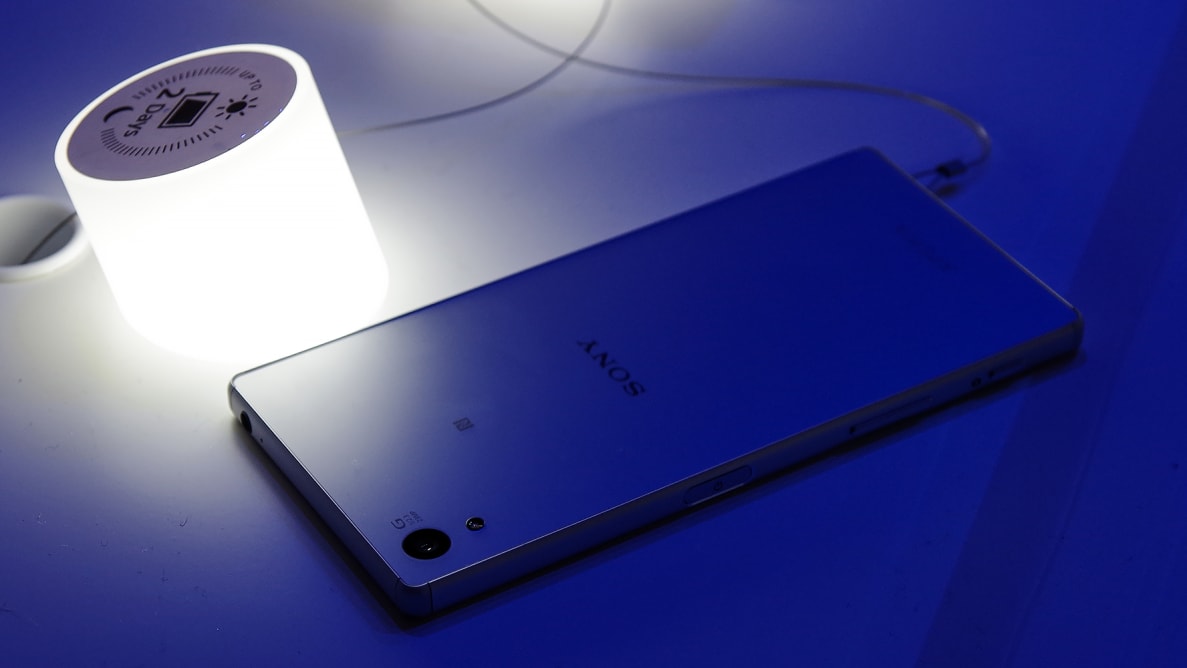Pros
Cons
It’s a real shame.
The phones boasted beautifully minimalist industrial design, a relatively clean re-skin of Android, and some excellent features, including one of the best smartphone cameras on the market. It’s no wonder the original Z3 has reigned as our top Android phone since its release.
At this year’s IFA trade show in Berlin, Sony announced the next generation of Xperia phones: the Z5, Z5 Premium, and Z5 Compact. The new devices represent a generally incremental upgrade over the Z3s, albeit with a few intriguing additions and alterations—4K screen, anyone? We went hands-on at Sony’s booth to find out whether the changes can give them a better shot at mainstream success.
The Options
In search of the Goldilocks option
Last time around, Sony offered the 5.2-inch Z3 and 4.6-inch Z3 Compact. Those sizes are back this year in the Z5 and Z5 Compact, but the company has also added the 5.5-inch Z5 Premium. With very few exceptions, the phones feature identical internals, which means you don’t have to give up performance to get the phone size you want.

All three Z5s boast Qualcomm’s top-of-the-line Snapdragon 810 processor. It’s a 64-bit chip with eight cores. That’s backed up by the Adreno 430 GPU and either 3GB (Z5 and Z5 Premium) or 2GB (Z5 Compact) of RAM. That’s the same combo that powers the HTC One M9, which wowed us in the labs, so we expect similarly solid performance from the Z5 series.
{{amazon name="SanDisk Ultra 64GB Ultra Micro SDXC UHS-I/Class 10 Card with Adapter (SDSQUNC-064G-GN6MA) [Newest Version]", asin="B010Q588D4", align="right"}} The demo units on the show floor certainly felt zippy enough. Running Sony’s lightly skinned version of Android 5.1.1 Lollipop, all three phones plowed through heavy webpages with ease and seemed to have no issues with gaming or video playback. We’re getting to the point where no flagship—or even midrange—smartphone should ever struggle with visible lag, so this comes as no surprise.
The Look and Feel
The perfect slab
We loved the design of the Xperia Z3 (with one noticeable caveat), and absolutely nothing has changed in that regard with the new Z5.

The Z5's glass back is unchanged from the Z3, except that the Z5 Premium gets a mirrored (rather than frosted) look.
These are still sleek, shiny, minimalist slabs crafted of mostly glass and metal. Like the flagship devices from Apple and Samsung, they feel reassuringly solid in your hand, with just enough curves to keep from digging into your flesh during a long call.
The edges of the Z5 and Z5 Premium are made of metal, while the smaller Z5 Compact uses plastic. It’s a downgrade, sure, but it doesn’t feel or look particularly cheap. All three have tasteful “Xperia” branding engraved in the lower left-hand side. Flip the Z5 and Z5 Compact over and you’ll find a frosted glass back, while the Premium variant has a flashier mirrored finish.
That glass back was our biggest pain point with the Z3’s design—when we put it on a smooth surface, it would sometimes walk itself right off and fall on the floor. We called it “a phone with a death wish,” and the Z5 doesn’t seem to be any different. Chances are, you’ll put a case on yours, but if not, be sure to keep an eye on it.
Like other Z-series phones, the Z5s have physical shutter buttons. They’re a rarity among non–Windows Phone devices, sought after by serious photographers the world over. You can long-press the shutter button to launch the camera app, and it offers a nice two-step action to help you prefocus and snap your shots.

Like other Z-series phones, the Z5s come equipped with a physical shutter release.
Right next to the shutter button is the volume rocker (oddly positioned toward the bottom of the phone), while the redesigned power button is a bit higher, near the centerline. The power button is bigger this time around, to accommodate the new fingerprint scanner. It’s the latest must-have feature for flagship phones, so it’s little surprise to find it here.
The Z5s are just as waterproof as their predecessors (IP68 certification), but this time around the USB port doesn’t require any extra protection. The little flap on the left side is still there, but it only covers the MicroSD card slot and SIM card port.
The Screen
Padding the numbers
The two biggest changes in the Z5 line are numerical: 4K and 23MP. Let’s start with the first.
The Xperia Z5 Premium boasts the world’s first 4K screen in a smartphone. Yes, that’s 3840 x 2160 resolution in a 5.5-inch screen, for more than 800 pixels per inch (PPI). For comparison, the iPhone 6 Plus (also 5.5 inches) offers 401 PPI, while the 5.7-inch Samsung Galaxy Note 5 claims 515 PPI.

The Z5's screen is bright and colorful, and looks plenty sharp even in 1080p.
Do you really need 4K resolution in a 5.5-inch phone? No, of course not.
Can you see the difference in everyday use? We sure couldn’t.
4K in a tablet? Sure, we can buy that. When you’re working with 8 or 10 or 12 inches of screen real estate and watching 4K content, it makes sense. But in something that’s going to spend most of its life scrolling through Instagram and Facebook? Nah.
Don’t get us wrong—there’s no denying it’s a gorgeous display, and Sony continues to offer best-in-class screen calibration tools so you can tweak the color profile to your heart’s content. The default look is pleasingly close to true white, without any hint of a blue or magenta cast, and color accuracy seemed pretty solid across the board.
The Camera
Mega megapixels
More so than the 4K screen, the new 23-megapixel, 1/2.3-inch Exmor-RS image sensor in all three phones seems likely to impress.
Sony should have a real edge in this department, given its strong history in compact cameras and the relatively large sensor it’s working with, but the Z3 (which was also a powerful shooter) didn’t quite live up to its potential in our tests. Still, at the phones’ unveiling, Sony CEO Kaz Hirai spent a lot of time talking up the camera’s prowess, and promised it’s the best the company has ever created for a smartphone.

Sony's camera app is intuitive and feature-rich. Paired with the new sensor, it should make the Z5 a great choice for serious smartphone photographers.
Kaz touted close collaboration between the Sony mobile and Sony Alpha teams in designing the new camera module, which could spell great things for smartphone photographers. In particular, he said the two worked together on autofocus speed and low-light performance—two issues that can be a real sticking point for phone cameras.
Indeed, the Z5s have some pretty impressive specs. The 1/2.3-inch sensor is what you’d get in a $200 point-and-shoot, which means it’s quite a bit bigger than most phone sensors. It can use up to ISO 12800 for low-light shooting, can focus in as little as 0.03 seconds, and has an upgraded SteadyShot intelligent active mode that can allegedly smooth out virtually all shaky video.

The Z5's camera module is a new 23-megapixel Exmor RS chip backed up by Sony's Bionz processor.
We took some test shots on the busy show floor, but it’s hard to tell much without being able to examine them more closely. On the phone screen, shots looked very sharp and well-exposed even in the murky trade show light, but there was clear evidence of hefty compression and noise reduction. We’ll have to wait to get the phone into our imaging labs to draw any firm conclusions.
The Takeaway
One of the best Android lineups gets better
If you liked what the Xperia Z3 and Z3 Compact had to offer, great news! The Xperia Z5 and its brethren are a solid upgrade to an already great package. If you didn’t even know the Z3 series existed, here's your opportunity to put right what once went wrong: When you shop for your next Android phone, give the Z5s a look.
We'll get the stuff we don't like out of the way first.

The new power button is chunkier, since it conceals the Z5s' new fingerprint scanner.
We're still not in love with Sony's UI. It's nowhere near as clean as vanilla Android—or even Samsung's or LG's skinning efforts—but it's relatively inoffensive. At the very least, it doesn't get in your way. Then there's the glass back. It's gorgeous—particularly the mirrored version on the Z5 Premium—but it's also a fingerprint magnet. Worse, it's a real liability if you're thinking about resting the phone on any kind of smooth surface. Better buy a case!
The Z5 Premium's 4K screen is a bit puzzling, but it's not exactly a negative—at least, not until we can see how it affects battery life in our tests. Are more pixels a bad thing? No, not in a vacuum. But do they add anything to the experience of using a 5.5-inch phone? Seems unlikely.
Those minor quibbles aside, the news here is all good. The Snapdragon 810 SoC is more than potent enough for just about any task, the display is gorgeous, and the camera seems extremely promising (though we know better than to expect miracles). But probably the coolest thing about the Z5s is that you don't have to give anything up to get the size you want. All three of these phones run cutting-edge hardware, they all sport beautiful design, and they should all get great battery life.
We'll confirm all that once we get them into the lab for testing, but for now, these are phones that should be on your radar.
Related Video
{{brightcove '4381856983001'}}
Meet the tester
Ben is an experienced industry journalist who formerly served as Senior Editor of News and Features at Reviewed. He now contributes as a freelance writer and editor. Most recently hailing from the vast wilds of the American southwest, he is an avid photographer who is deeply disturbed by the lack of wide open landscapes in Boston.
Checking our work.
Our team is here to help you buy the best stuff and love what you own. Our writers, editors, and experts obsess over the products we cover to make sure you're confident and satisfied. Have a different opinion about something we recommend? Email us and we'll compare notes.
Shoot us an email




